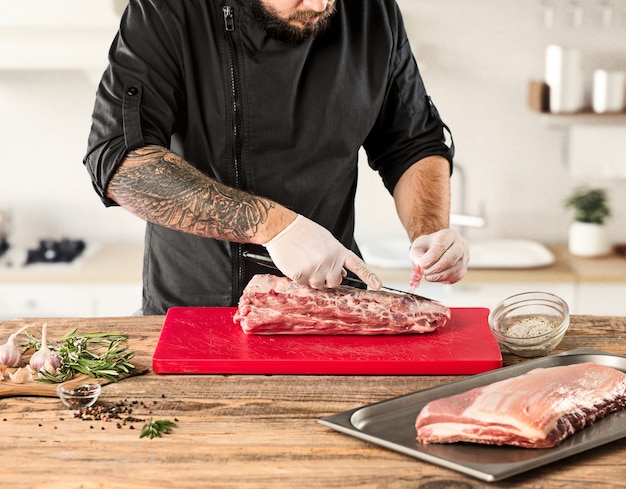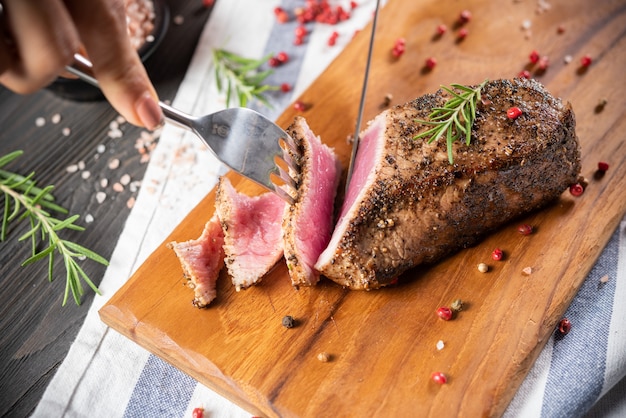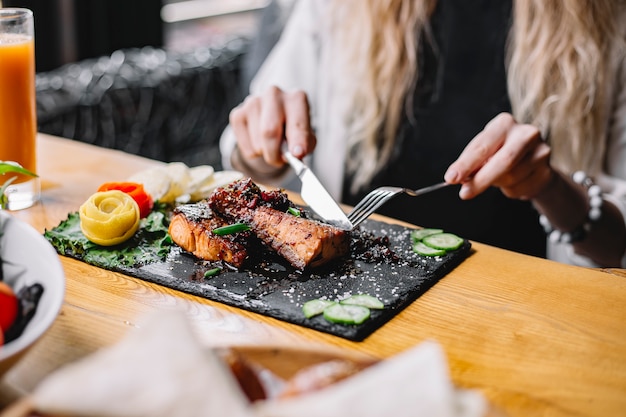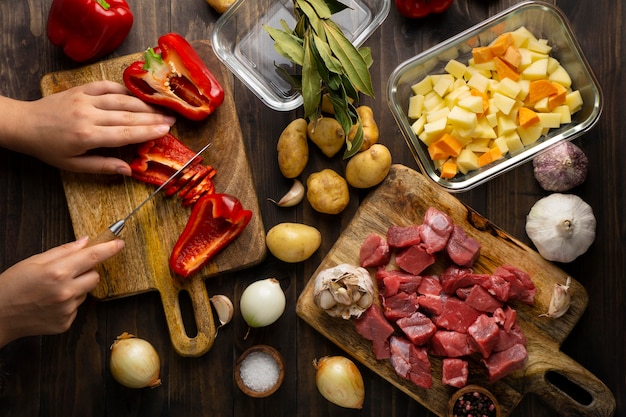Ah, the perfectly cooked steak. There's nothing quite like that beautiful sear, the juicy, tender bite, the satisfying aroma that fills the air. It's a culinary triumph, a testament to patience, precision, and a dash of culinary intuition. But achieving that coveted medium doneness, without ending up with a tough, dry, or worse, raw steak, can be a bit of a challenge.
I've been there, folks. I've spent countless hours in my kitchen, experimenting with different cuts, grilling techniques, and seasonings, all in pursuit of the ultimate medium steak. I've learned from my mistakes, embraced my successes, and developed a foolproof guide to grilling that juicy, flavorful steak you've always dreamt of.
Forget those intimidating culinary terms and complex recipes. This is a guide for the everyday cook, a roadmap to mastering the art of steak grilling, based on years of trial and error, and a whole lot of deliciousness. So grab your apron, fire up the grill, and let's get started!
Part 1: choosing the right cut - The Foundation of a perfect steak

The journey to a perfect medium steak begins with choosing the right cut of meat. It's not just about personal preference; it's about picking a cut that's naturally suited for grilling and will yield that juicy, tender centre we all crave. Think of it as choosing the right canvas for your culinary masterpiece.
The Classics: A Timeless Choice
There's a reason these cuts have become the go-to choices for steak lovers. They're typically thick, marbled with fat, and have a distinct flavour that holds its own on the grill. These are the cuts that are often showcased in restaurants and are considered the gold standard for grilling.
- Rib Eye: This cut is a real crowd-pleaser, known for its beautiful marbling, which translates to incredible tenderness and flavour. The fat is distributed throughout the meat, creating a succulent, juicy steak with a buttery, rich taste. It's a perfect choice for a special occasion or a celebratory dinner.
- new york strip: Another marbled beauty, the strip steak boasts a larger surface area compared to the rib eye, offering a slightly different flavour profile. It's a versatile cut that works well with different seasonings and grilling techniques, and it's a great choice for a quick weeknight meal.
- filet mignon: A classic for a reason, the filet mignon is known for its incredibly tender and buttery texture. It's leaner than the other two, so it's important to not overcook it. This cut is often served with a rich sauce and is perfect for a romantic dinner for two.
Beyond the Classics: Discovering Hidden Gems
If you're looking to explore beyond the usual suspects, there are a few more cuts worth trying. These cuts might not be as well-known, but they offer unique flavors and textures, making them a great way to expand your grilling repertoire.
- T-Bone: A hefty cut with a T-shaped bone, this steak offers a combination of tender filet mignon and flavourful New York strip in one piece. It's perfect for a hearty meal for two or for sharing with friends.
- Porterhouse: Similar to the T-bone, but with a larger filet mignon section, making it a real steak lover's dream. This is a truly impressive cut and is often served at high-end restaurants.
- flat iron steak: This cut is a hidden gem! It's leaner than rib eye or strip, but offers a surprising amount of flavour and tenderness. It's also a more budget-friendly option.
The Thickness Factor: The Key to Juicy Tenderness
When choosing your steak, remember this: thicker is generally better. A thicker steak allows for more even cooking and ensures a juicy, tender centre. Think of it as a thicker layer of meat to hold those delicious juices. Aim for a steak that's at least 1-inch thick, ideally 1.5 inches or more.
Part 2: Preparing the Steak - Setting the Stage for Success

Now that you've chosen the perfect cut, it's time to prepare your steak for grilling. Just like a good actor needs a proper warm-up, your steak needs a little bit of time and attention to ensure it performs its best on the grill.
Bringing it to Room Temperature: Unlocking Even Cooking
Taking the steak out of the fridge about 30 minutes before grilling allows it to come to room temperature, which ensures even cooking. Think of it as letting the steak "breathe" before it hits the heat. Cold meat cooks unevenly and can lead to a tough outer layer and a cold, undercooked centre.
Seasoning: The Art of Enhancing Flavor
Keep it simple and classic. Salt and pepper are the ultimate flavour enhancers for a steak. Generously season the steak on both sides about 30 minutes before grilling. Don't be shy! The salt will draw out moisture, which will create a more flavorful crust and tenderize the meat.
The "Dry Brine" Trick: A Secret to Tenderness and Flavor
If you want to take your seasoning game up a notch, try a dry brine. It's a simple yet effective technique that transforms your steak into a flavor sensation. Simply sprinkle the steak generously with salt and leave it uncovered in the fridge for a few hours. This allows the salt to penetrate the meat, resulting in a more tender and flavorful steak. The salt draws out moisture, which then evaporates, leaving behind concentrated flavor and a perfectly seasoned steak.
Part 3: The Holy Grail: The Grill - Your Culinary Weapon of Choice

Now comes the fun part: the grill. But let's be honest, not all grills are created equal. For a perfect medium steak, you need a grill that can deliver consistent, even heat. It's the heart of your grilling operation, the tool that will transform your steak from raw to a culinary masterpiece.
Gas vs. Charcoal: The Great Grill Debate
The eternal debate! Gas grills are convenient, easier to control, and heat up quickly. They're the perfect choice for busy weeknights when you need to get dinner on the table fast. charcoal grills, on the other hand, offer that irresistible smoky flavour. They add a depth of flavor that you can't get with gas, making them a favorite among true grilling enthusiasts. Ultimately, the choice comes down to personal preference. I personally prefer the smoky depth that charcoal brings, but gas is a great option for busy weeknights.
Getting Your Grill Ready: Creating the Perfect Grilling Environment
Whether you're using gas or charcoal, preheating your grill to high heat is essential. This creates a searing hot surface that will create a beautiful crust on your steak. For gas grills, preheat to medium-high (around 450°F). For charcoal grills, use enough charcoal to create a bed of hot coals.
Think of it as prepping your grill for a performance. A hot grill will sear the steak beautifully, locking in juices and creating a flavorful crust.
Part 4: The Art of Grilling - Transforming Raw to Delicious
This is the moment of truth. Grilling a steak is more of an art form than a science. It takes practice, patience, and a little intuition. It's a dance between heat, time, and your own culinary instincts.
Searing the Steak: Building a Flavorful Foundation
The key to a juicy, flavorful steak is to sear it over high heat. This creates a delicious crust and locks in the juices. Think of it as building a strong base for your steak to stand on. Place the steak on the grill and let it sear for about 2-3 minutes per side. Don't move it around too much; let it develop a nice, crispy crust.
The Flip: A Crucial Moment in the Grilling Process
Once you've seared both sides, it's time to flip the steak. You can use tongs or a spatula, but be careful not to pierce the meat, as this will release juices. Think of it as a delicate ballet move, flipping the steak gently to ensure you don't disrupt its cooking process.
Grilling Time: A Balancing Act of Heat and Time
This is where your intuition comes in. The cooking time for a steak depends on its thickness, desired doneness, and the heat of the grill. Think of it as a dance between heat and time, where you need to find the perfect balance to achieve your desired level of doneness. Here's a general guideline:
| Doneness | internal temperature | Cooking Time (per side) |
|---|---|---|
| Rare | 125°F - 130°F | 2-3 minutes |
| Medium-Rare | 130°F - 135°F | 3-4 minutes |
| Medium | 135°F - 140°F | 4-5 minutes |
| Medium-Well | 140°F - 145°F | 5-6 minutes |
| Well-Done | 145°F - 150°F | 6-7 minutes |
The Resting Period: Allowing the Steak to Relax and Rejuvenate
Once you've reached your desired doneness, remove the steak from the grill and let it rest for 5-10 minutes. This allows the juices to redistribute, resulting in a more tender and juicy steak. Think of it as a well-deserved break for the steak to regain its composure. Cover the steak with foil to keep it warm while it rests.
Part 5: The Ultimate Test: The Internal Temperature - Ensuring Perfect Doneness
The key to achieving that perfect medium doneness lies in knowing the internal temperature of the steak. A meat thermometer is your best friend! Think of it as a culinary detective, revealing the secrets of your steak's internal temperature. Here's a breakdown of ideal temperatures for different doneness levels:
- Rare: 125°F - 130°F
- Medium-Rare: 130°F - 135°F
- Medium: 135°F - 140°F
- Medium-Well: 140°F - 145°F
- Well-Done: 145°F - 150°F
Insert the thermometer into the thickest part of the steak, avoiding the bone. Once the internal temperature reaches your desired level, remove the steak from the grill and let it rest.
Part 6: The Finishing Touches - Elevating Your Steak to Perfection
A perfect steak deserves a grand finale. Think of it as adding the final touches to your culinary masterpiece, ensuring every element is in perfect harmony.
Resting: Allowing the Juices to Redistribute
As mentioned earlier, letting your steak rest for 5-10 minutes is crucial. This allows the juices to redistribute, ensuring a more tender and juicy steak. Cover the steak with foil to keep it warm while it rests. It's a simple but essential step that makes a big difference in the final result.
Slicing: Unlocking Flavor and Tenderness
Once the steak has rested, slice it against the grain. This helps to tenderize the meat and allows the flavours to be released. Think of it as revealing the steak's true potential, allowing the flavors to shine.
Sauce: A Symphony of Flavor
While a perfectly grilled steak needs no embellishment, a simple sauce can elevate the flavour experience. Think of it as adding a touch of elegance and complexity to your culinary creation. Here are a few classic steak sauces that complement the natural flavours of the meat:
- Béarnaise Sauce: A rich and creamy sauce made with egg yolks, butter, vinegar, and herbs. It adds a touch of richness and acidity to the steak.
- Red Wine Sauce: A robust sauce made with red wine, shallots, and herbs. It complements the steak's natural flavors with a touch of earthy depth.
- Mushroom Sauce: A savory sauce made with mushrooms, onions, and herbs. It adds a touch of umami and earthiness to the steak.
- Blue Cheese Sauce: A creamy and tangy sauce made with blue cheese, cream, and herbs. It provides a unique, bold flavor that contrasts beautifully with the richness of the steak.
Sides: Complementary Flavors and Textures
No steak is complete without the right sides! Think about textures and flavours that complement the richness of the steak. Think of it as creating a harmonious culinary ensemble, where each element plays a crucial role.
- Roasted Vegetables: roasted asparagus, broccoli, or Brussels sprouts are a classic pairing. They provide a vibrant burst of color and flavor that contrasts beautifully with the richness of the steak.
- Creamy potato gratin: A creamy and comforting side that complements the richness of the steak. It adds a touch of indulgence and elegance to the meal.
- mashed potatoes: A classic comfort food that pairs well with any steak. It provides a comforting and familiar base for the steak.
- Sautéed Mushrooms: A simple yet flavorful side that adds a touch of earthiness to the dish. They complement the steak's savory flavors and add a touch of texture.
Part 7: Mistakes to Avoid - Avoiding Common Grilling Pitfalls
We all make mistakes, even seasoned grill masters. Here are a few common errors to avoid when grilling your steak. Think of it as learning from the experiences of others, avoiding common pitfalls that can lead to a less-than-perfect steak.
Overcrowding the Grill: Ensuring Even Cooking
Don't overcrowd your grill! This will lower the temperature and prevent the steak from getting that beautiful sear. Grill the steaks in batches if necessary, ensuring there's enough space between each steak for even cooking. Think of it as giving each steak the space it needs to breathe and cook evenly.
Piercing the Steak: Preserving Juices and Flavor
Resist the urge to poke and prod your steak while it's grilling. This will cause the juices to escape, resulting in a dry and tough steak. Think of it as treating your steak with respect, allowing it to cook undisturbed to maintain its tenderness and flavor.
Using a Fork: Avoiding Unnecessary Puncture
Avoid using a fork to flip the steak. It can puncture the meat, releasing valuable juices. Use tongs or a spatula instead. Think of it as using the right tools for the job, ensuring a gentle flip that doesn't disrupt the steak's cooking process.
Cutting the Steak Too Soon: Allowing Time for Juices to Redistribute
Be patient! Let the steak rest for at least 5-10 minutes before slicing. This will allow the juices to redistribute, ensuring a more tender and juicy steak. Think of it as giving the steak a chance to relax and recover from the grilling process, resulting in a more flavorful and tender steak.
Part 8: Frequently Asked Questions - Answering Your Grilling Queries
Here are some frequently asked questions about grilling the perfect steak, addressing common concerns and providing helpful advice. Think of it as a Q&A session with your personal grilling guru.
1. What is the best way to cook a steak to medium?
The key to achieving medium doneness is to cook the steak to an internal temperature of 135°F - 140°F. Use a meat thermometer to ensure accuracy. You can use a grill, pan-searing, or oven to cook the steak. Think of it as using a trusty tool to ensure your steak reaches the perfect level of doneness.
2. How long does it take to cook a medium steak?
The cooking time depends on the thickness of the steak and the heat of the grill. For a 1-inch thick steak, it will generally take about 4-5 minutes per side. For a thicker steak, you may need to add extra time. Think of it as a balance between the thickness of the steak and the heat of the grill, where you need to adjust the cooking time accordingly.
3. What is the best way to tell if a steak is cooked to medium?
The best way to determine the doneness of a steak is to use a meat thermometer. An internal temperature of 135°F - 140°F indicates medium doneness. You can also use the "touch test", but this method is less accurate. Think of it as using a reliable tool to confirm the steak's doneness, ensuring a perfect result every time.
4. What are the best cuts of meat for grilling?
The most popular cuts for grilling are rib eye, New York strip, and filet mignon. These cuts are typically thick, marbled with fat, and offer a rich flavour. Other good choices include T-bone, Porterhouse, and flat iron steak. Think of it as exploring a variety of cuts, each offering unique flavors and textures.
5. Can you overcook a steak?
Yes, absolutely. Overcooking a steak will result in a dry and tough piece of meat. The key is to use a meat thermometer and cook the steak to the desired doneness. Think of it as finding that perfect balance between heat and time, ensuring a juicy and flavorful steak.
So there you have it, my ultimate guide to grilling the perfect medium steak. It's a journey that takes practice, patience, and a bit of intuition, but the rewards are worth it. Enjoy the process, savor the flavour, and embrace the joy of cooking a steak to perfection.
Everyone is watching

Perfect Rice Every Time: The Ultimate Guide to Cooking Rice
Cooking TipsAs a self-proclaimed foodie, I've always been a bit obsessed with rice. It's the foundation of countless cuisi...

Ultimate Guide to Cooking the Perfect Thanksgiving Turkey
Cooking TipsThanksgiving. Just the word conjures up images of overflowing tables laden with delicious food, the scent of r...

The Ultimate Guide to Cooking Asparagus: Tips, Techniques, and Recipes
Cooking TipsAsparagus. The mere mention of this spring delicacy conjures up images of vibrant green spears, crisp and burs...

Can You Cook Spaghetti with Gasoline? (The Shocking Truth)
Cooking TipsWe've all seen those crazy internet trends. You know, the ones that make you wonder, "Did someone actually try...

Chorizo and Eggs Recipe: The Ultimate Guide
Cooking TipsRight, let’s talk about chorizo and eggs. You know, that classic Spanish dish that's always a winner. It's th...
